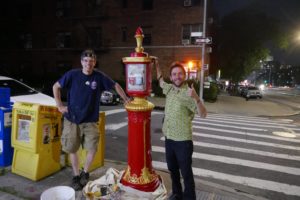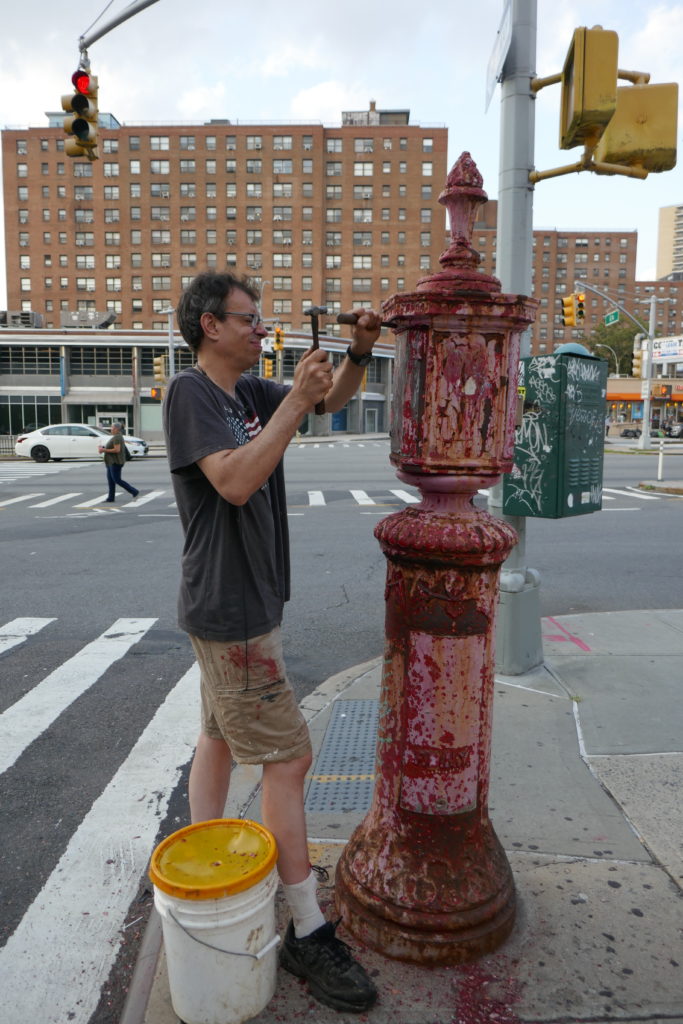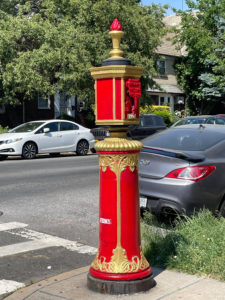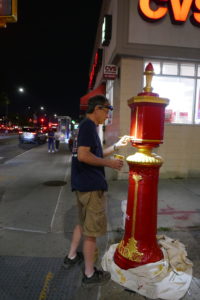By Michael Perlman
mperlman@queensledger.com
One-man dynamo John S. Colgan, a.k.a. the “fire alarm box guy,” may soon be coming to a street corner near you. With originality and creative energy, precision, long-term dedication, and a civic mind without taking a penny from politicians, his aim is to restore and accentuate historic, but long-forgotten Beaux-Arts meets Art Nouveau fire alarm call box pedestals that read NYC all over it. As residents observe Colgan’s unique talent and become an audience, it becomes evident how volunteering is the cultivation of the soul, as preserving a lost art form is nourishment for the soul.
For the past year, one of his many projects is the soon-to-be complete restoration of the neglected 67th Avenue and Queens Boulevard fire alarm pedestal in Forest Hills, which dates to 1929, and even predates the opening of the local IND subway by 7 years. Sometimes late at night, layers of paint were meticulously stripped away, gaps and rust vanished, and primer and layers of traditional red paint were applied. Now its ornate craftsmanship, consisting of vine-like designs and a torch, is continuing to be accentuated in layers of gold.
Today, there are an estimated 15,077 fire alarm boxes, where a majority of the ornate models date to 1913, 1921, and 1931, whereas non-descript models date as far back as 1957. “I don’t really know how many fire alarms I’ve painted in total, but it could be around 100 or 200,” said 46-year-old Colgan, a handyman, and painter from Woodside who began restoring alarms in 2012. He accentuated the details in gold of approximately 30, consisting of six in Bayside Hills, one to date in Forest Hills, at least five in Long Island City, two in Sunnyside, five in Woodside in various stages of repainting and repair, five in Astoria, and others at random throughout Queens.
Besides the 67th Avenue alarm, he has his eyes set on painting nine others before summer’s end, which include two in Douglaston, two in Bayside, two in Bayside Hills, one in Whitestone, and two in Woodside. In 2021, this columnist led Colgan on a survey of Forest Hills and Rego Park fire alarms, and through Facebook, residents also suggested alarms to restore.
Above all, Colgan is a man of gratitude. He said, “My mother and I originated this project, so she is my inspiration. She taught me to ‘fight till the end and never give up,’ so I’m on a mission to save as many FDNY fire alarms as possible. Every alarm painted is one saved. My mother instilled a sense of community within me.”
At that time, he was unemployed and his mother suggested that he “paint the neighborhood” and “give back by leading by example.” He reminisced, “I began by covering the graffiti on lampposts, and then hydrants and sign poles, followed by mailboxes. Then I ran out of things to paint. One day while sitting on the front steps of my mother’s house, I noticed the ugly condition of the fire alarm on the corner of 32 Avenue and 54th Street, so I went to Gleason’s on 69th and got a gallon of Maxtech Gloss Red. After I painted it red, I thought the lace work might look nice with some gold on it, and then Bam! I stepped back, looked at it, and the rest is history.”
Colgan loves restoring fire alarms for free, as his gift to the community. He explained the intricate nature of the restoration process. “You have to be dedicated and tough. I’m out in all sorts of weather, but mostly when it’s hot. In the winter, I use an old wood chisel to chip off the paint, since it saves time, and the acid paint remover does not work when it’s too cold or wet. The painting is always the restoration’s easy component. It’s very relaxing, and I go into a trance, where nothing else matters other than the little square I’m working on.”
As significant and picturesque as the alarms are, Colgan considers the 67th Avenue alarm the most challenging and poorly manufactured model that he worked on in ten years. He explained, “This 1929 alarm does not appear on the official fire alarm blueprints. Through my own observations, I surmise that the FDNY tried to save money by taking the alarms away from the craftsmen and giving them to an assembly line with regular workers. Not only are these alarms of poor craftsmanship, but the metal is a low grade. I had to fix the crumbling cast iron. The lace work is also missing pieces, so technically it’s incomplete.”
It is also the “busiest alarm” that Colgan ever restored. He explained, “Most of the time I’m in front of someone’s house on a lonely Queens street, but on 67th Ave, I met and spoke to at least 1,000 people since I started last September. I’ve had great conversations with a ton of elderly people.” At least one resident usually sits on the corner, as they watch the paint dry, and others show up routinely to witness his progress and offer moral support.
Colgan is interested in establishing a Facebook group poll on color schemes, since gold accents are sometimes offset by hints of black for contrast, or the placement of colors varies. He said, “The plan is for the community to get involved in the final stages of paint. After all, you have to look at it, but I will be moving on to the next alarm.”
Additionally, there are five other alarms that Colgan is considering restoring in Forest Hills and Rego Park. “They are in bad shape, so I don’t think I will get to them this season,” he said.
Much is still being discovered about the history of fire alarm pedestals. Colgan explained, “The first fire alarms were acquired and improved by John Gamewell from the 1850s to the 1880s. The original alarm was based on the Morse Telegraph system. After the Civil War, the US government stole all of the patents from southern inventors and sold them for nothing on the Capitol Steps. Then one of Gamewell’s employees brought his fire alarm patents and started the company back up in Hackensack. He sold the patents back to John Gamewell for $1. From there, the company erected a huge factory (still standing) in Newton, Ma. At one point, Gamewell Co. had a 95 percent share of the fire alarm market. The alarms changed very little since the 1900s. The real difference in my opinion is that the signal is a little more efficient, but the overall design is the same. Gamewell was very good at perfection.”
Preserving the remaining historic fire alarms on-site is essential since unfortunately, some received mundane rectangular replacements. Colgan said, “It took years for me to figure out how to get the paint to stick to the alarm for seven years, and I’m just a painter. I cannot imagine the level of skill that was required to produce just one alarm.” Today, alarms are being repurposed. “They act as a landmark for the FDNY technicians looking for an FDNY manhole,” he continued.
Colgan is a humanitarian on many levels. “My only goal is to honor my mother by doing nice things for people and expecting nothing in return. The only person responsible for your neighborhood is you. Less government and more volunteer work is the solution. If you don’t expect anything in return, then you will get tons of love from fellow New Yorkers,” he said.
“John is truly a magician with the magic that he performs to restore these works of art and history,” Ivy Chait-Skow said. “Forest Hills has such wonderful architecture and historical features, and we need to preserve what we can.”
CVS supervisor Jason Biddle is proud to see a familiar site undergoing restoration. “John Colgan took hours upon hours of his time to bring it back to its original form. It looks very authentic, and I feel that he deserves a lot of credit.”
Early on, it caught David Edelman’s eye. He explained, “Witnessing John Colgan devote extreme time and effort to painstakingly restore a fire alarm in the heat, rain, and darkness evokes a sense of community pride and ownership over our neighborhood that is so desperately needed, especially now, to counteract the forces of neglect that is too often the norm. When an old firebox is restored to majestic condition, it draws attention, perhaps enough that it invokes a desire to learn more and do more to continue to improve our neighborhood and city. I wish every neighborhood could have a restored firebox.”

Restoration expert John Colgan with surveyor Michael Perlman during the restoration of the 67th Ave alarm restoration
“The restored fire alarm is a sign of hope and resilience for the whole community after 2 years of Covid and a criminal spike,” said Vania Martini. “It gives a sense of reassurance that great humanity is out there in the form of John. Everyone can apply their talent towards community service, so I hope more people will get inspired.”
For Kevin Sanichara, seeing this rare act of restoration brought immense joy. He explained, “John did an amazing job! It’s a step in the right direction of bringing back order and cleanliness. We cannot sit around and wait for others to create the positive change we seek. Those fire boxes from the 1920s have a wonderful architectural design, and I want to see more of that and other local restorations whenever possible.”
“I tip my hat to John Colgan,” Elana Kirschbaum said. “Volunteering and historic preservation are huge since, without either, we won’t have anything left of our neighborhood that we know and enjoy.”





